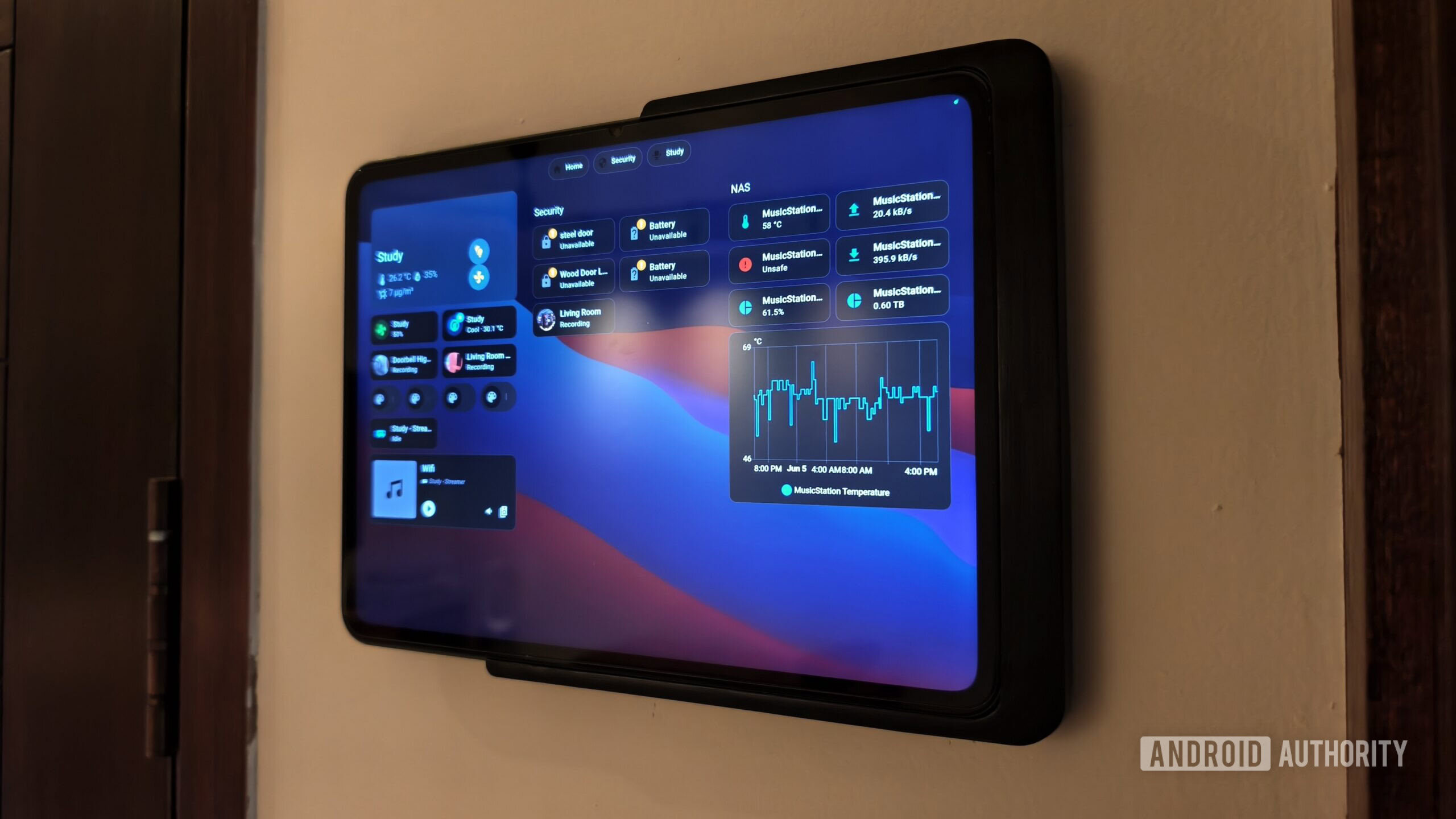
Contents

Dhruv Bhutani / Android Authority
Recently, when I started renovating my home, I knew it was the perfect time to rebuild my smart home from scratch. I’ve been on the smart home bandwagon for years, but cobbling together IoT products is never the right approach. Some things work, some don’t, and some don’t work quite as well as you’d want them to.
The best smart homes are the ones you never have to think about.
Over the years, I’d pieced together a mix of gadgets, platforms that included Alexa, Apple’s HomeKit and Google Home. And, of course, half-finished ideas. This time, I wanted something more deliberate based on my actual experience and requirements. No, that did not include a flashy setup packed with voice commands and novelty routines, but a smart home that just worked — reliably, quietly, and without falling apart the moment the power flickered or the WiFi stuttered. Clean wiring, stable connectivity, and simple automations that make daily life easier and seamless was the goal. Here are the five biggest takeaways from that rebuild and how I achieved it.
Drop wired internet wherever possible — and do double drops if you can

Dhruv Bhutani / Android Authority
If you’re opening up walls anyway, run Ethernet. I pulled CAT6 to every room and doubled up in key spots like my office, living room, and media cabinet. It’s a low-cost move during renovation that gives you flexibility for years. In fact, one of those extra drops came in handy right away. I accidentally drilled through a cable while mounting a shelf, and having a backup line already in place saved me from opening up the wall again.
Even though I already had a solid mesh WiFi network, I still prioritized wired connections wherever I could. Mesh is great for general coverage, but it can’t match the stability, low latency, and consistent speed of Ethernet. Wired lines also cut down on interference and congestion, which is something you notice quickly in smart homes where dozens of devices are chatting constantly.
Every device you can hardwire frees up bandwidth for what actually matters.
Every device you can hardwire, be it a streaming box, smart TV, access point, NAS box, or small server, takes pressure off your WiFi and frees up bandwidth for things that actually need to roam — like the best smartphones. That means fewer random dropouts, and less troubleshooting.
I went with CAT6 because it’s fast, future-proof, and supports gigabit speeds easily. For shorter runs it’ll even do 10 gigabit speeds with ease. It’s also perfect for running Power over Ethernet, which I leaned into heavily for hubs like the one for my Aqara smart lock, Ubiquiti cameras, and sensors. More on that later. My general rule is that if you can run a conduit through a wall and you think you might use it, pull the cable now. You won’t regret it. I’ve even got spares running to the laundry room.
More power points are good, but PoE is better

Dhruv Bhutani / Android Authority
You can never have too many power outlets, especially in corners where you think you won’t need them. But even better than a wall full of plugs is eliminating them altogether with Power over Ethernet. A lot of newer smart home gear supports PoE, and I used it wherever possible, especially for things that need to stay on 24/7.
PoE is cleaner, more reliable, and less fussy. You get power and data through one cable, and that simplifies everything — fewer random power bricks, fewer USB adapters, and fewer loose ends. For stuff like smart sensors, cameras, or even certain hubs like the Aqara smart hub, it means you can place them exactly where they need to be without worrying about where the nearest plug is. This does mean higher up-front costs. Sensors supporting PoE tend to cost more and you’ll need to invest in a PoE-capable network switch.
A small UPS can save your setup during power outages and against errant surges.
Just as important is planning for power redundancy. I added a small uninterruptible power supply (UPS) to keep my router, main switch, and smart home hub online during power outages. That way, even if the lights go out, I can still control scenes or turn stuff off manually. A second battery pack handles backup power for a few critical devices, like the NAS and a central tablet that controls everything. With the sheer expense of building out a setup like this, power backup doesn’t just offer peace of mind of not being stuck in the dark waiting for things to reboot, but also acts like a first line of defence against power surges. I’d rather lose a UPS than my entire smart home network.
Avoid WiFi-based devices where you can

Dhruv Bhutani / Android Authority
A lot of starter smart home gear runs over WiFi. Many years ago, I too kickstarted my smart home with Xiaomi’s WiFi-based smart bulbs. It’s easy to set up, but it just doesn’t scale well. Once you’ve got a dozen or more devices competing with your phones, laptops, TVs, and everything else, things get crowded fast. With over 50 smart bulbs in my apartment, I knew that wasn’t a scalable solution.
Instead, I moved almost everything over to Zigbee. It’s low-power, designed for always-on sensors and switches, and doesn’t clog up your main network. Z-Wave is another good option, especially if you’re in a region with broader support. Both standards are mature, reliable, and most importantly, they work offline. So if your internet goes out, your routines and automations still function normally.
WiFi-based gear is easy to start with, but hard to scale.
Another advantage is lower latency and better mesh coverage. Each device in a Zigbee setup can help extend the network, so the more you add, the better the whole system gets. No range extenders or fancy tricks needed. I opted for Philips Hue lighting because of wide availability, great CRI rating and rock-solid reliability. However, you can opt for other options like Ikea’s smart bulbs. In fact, my colleague Mitja used those in his smart home build out and reported great results.
Elsewhere, I also started looking for Matter support where it made sense. It’s still early days, but having devices that are Matter-capable is a good bet for the future. The goal wasn’t to chase trends, but to avoid getting locked into something that’ll be a dead end in a few years.
Finally, unless absolutely necessary, I avoided cloud-only devices. If something doesn’t work without an internet connection, I didn’t want it going into my smart home setup. As it stands, my ceiling fan is the only device on my network that is cloud-first and even that can be hacked into for local control. I just haven’t gotten around to it yet.
Overbuild your WiFi network from the start

Dhruv Bhutani / Android Authority
Even if your smart home doesn’t rely on WiFi, your life still does. Phones, tablets, laptops, streaming boxes all runs over wireless. So I took this chance to build a strong, stable WiFi network that wouldn’t need constant patching or range extenders.
I hardwired multiple access points, three in total, all tied back to a central switch. That gave me rock-solid coverage across the entire house, plus fast, reliable performance for anything that does need WiFi. And I didn’t cheap out here. For this build, I repurposed my business-grade WiFi equipment and added additional network switches to it. Proper set up is just as important. That means setting the right power settings on access points and avoiding congested wireless channels. Just a good router, solid APs, and Ethernet backhaul everywhere possible can make a huge difference. That one-time investment meant I haven’t had to troubleshoot random WiFi dropouts or laggy video calls for years.
Also, if you’re running local smart home servers, Home Assistant dashboards, or even casting audio across rooms, strong WiFi still matters. A good wired backbone makes the wireless side better too with faster roaming, less interference, and smoother handoffs between devices.
Don’t automate everything

Dhruv Bhutani / Android Authority
One of the easiest traps with smart homes is trying to automate everything. It sounds great in theory: millimetre-wave sensors that enable lights that follow you, fans that spin up automatically, and voice controls in every room. But in practice, that level of automation often gets annoying. Things misfire, conditions change, and you end up fighting with the system instead of benefiting from it. I’m talking from experience.
So I took a more intentional approach. I rebuilt Home Assistant from scratch, and for every automation, the first question I’d ask was, “How does this improve my life?” Motion-based lighting made sense in transitional spaces like hallways, bathrooms, or my staircase, where I didn’t want to fumble for a switch. But in living areas or bedrooms, I kept manual and voice control options. Same with temperature-based fan control — it’s helpful in certain conditions, but not when weather shifts quickly or someone just opened a window. The fan near my record collection is automated to spin up at a certain threshold because I don’t want my precious music turned into warped plastic in Delhi’s heat. The other spaces? Manual controls work just fine.
When your hands are full, voice control is great, but it shouldn’t be the only way to trigger a light or turn on the fan. I made sure there were physical controls as backups for everything. Hidden switches act as an old-school backup if everything goes haywire. Meanwhile, a centrally mounted tablet acts like the control centre for my living room. Lights in the bedroom are controlled via Zigbee remotes. A good smart home should feel invisible when you don’t want to think about it. That’s the goal — not to impress visitors with flashy tech, but to quietly make your life a little smoother. And I think I got pretty close to achieving it.
Bonus: Plan for a central control point

Dhruv Bhutani / Android Authority
This one’s easy to overlook. We get used to pulling out our phones or using voice commands, but having a central spot to control everything makes a big difference. In my case, I mounted a tablet on the wall next to the entrance to my apartment. It’s easy to reach, displays the time when not being used, and remains easily accessible. It runs a custom Home Assistant dashboard that controls lights, fans, appliances, cameras, and more, and is the hub I go to when I need to check on something quickly or trigger a scene.
I also hid most of the backup switches and wiring behind a central panel. That way, everything is clean on the outside, but still easily serviceable. Think of it like a breaker box but for your smart home.
The best smart homes are the ones that are invisible
Rebuilding my smart home taught me that reliability, not novelty, is what really matters. It’s easy to get distracted by nerdy features and voice control gimmicks, but the best smart homes are the ones you don’t have to think about. A solid wired backbone, well-planned power and connectivity, and a balance between automation and control go a long way in creating a system that just works. Whether you’re starting from scratch or fine-tuning an existing setup, planning with longevity and simplicity in mind will save you time, money, and a whole lot of headaches down the line.
What’s your reaction?
Love0
Sad0
Happy0
Sleepy0
Angry0
Dead0
Wink0








Leave a Reply
View Comments